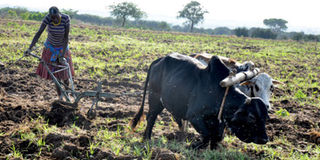Karamoja finds gold in farming

A farmer cultivates a piece of land using ox-ploughs in Kotido District last week. PHOTO BY STEVEN ARIONG
Nakapiripirit- As the sun glimmers, Mr Charles Akope, 34, emerges from his mud and wattle hut with an ox-plough.
Holding a stick on his shoulders, he moves towards the cattle kraal and selects two well-built bulls and heads to his farmland, a few metres away to prepare for planting crops such as maize.
Mr Akope’s family is among households that have so far embarked on crop farming in Karamoja Sub-region to fight food insecurity and increase household income, after years of herding cattle.
Ms Amina Akol, 44, another resident and member of Riamiriam Farmers Field School in Moruita Parish, Moruita Sub-county in Nakapiripirit District, who practises group farming on a large scale, says abandoning pastoral lifestyle was challenging.
“At first we were hesitant because we had got used to pastoral lifestyle but now we have realised that farming is more rewarding and it is the ideal solution to food insecurity in our households,” she says.
She says because they engage in large scale farming, they are able sell in bulk and this has enabled them earn more from their harvests due to collective bargaining power.
Mr Lotomeyilo Kerisone, another resident from Kotido District, says before embracing farming, he was a cattle rustler, a practice he says was not rewarding.
“We used to raid the neigbouring communities and steal their cattle but have now stopped and decided to join our women who were already practising farming on small-scale,” he says. He says his family now owns more than100 acres of groundnuts and sorghum.
Mr Paul Muron, another resident, says they are able to earn more from their harvests to support their children’s needs, including education.
“We can ably take care of our children’s needs, including school fees and shelter. Like in my family, we have managed to construct iron-sheet houses, which was not in our dreams,” he says.
“We can harvest more than 30 bags of maize, each season. Each bag goes for between Shs70,000 and Shs90,000.”
Farming
Karamoja Sub-region, an area that has always been hit by food insecurity, comprises several tribes, with majority being Karimojong. Others include Jie, Turkana, Dodoso, Nyakwai, Toposa and Nyangatom. Previously, their main source of livelihood was herding cattle due to their pastoral background.
Mr Elhadji Amadi Yadanga, a community facilitator in Kotido District, says several homes are now practicing farming.
“We are happy that most of the families have come to consensus and resolved to settle down, plough their land for crop growing and educate their children in order to cope with changes in the contemporary world,” he says.
In a bid to support farming in the sub region, the government through the Office of the Prime Minister, got funding worth $130 million (Shs497 billion) from the World Bank to implement the Third Northern Uganda Social Action Fund (NUSAF3) project, which is being piloted in Nakapiripirit, Amudat, Moroto, Kotido, Abim, and Kaabong districts.
Sustainable income
Mr Simon Kiseka, the NUSAF communications specialist, says the move is aimed at encouraging residents to have a sustainable income through productive and commercial farming.
“This will elevate communities from hunger and poverty that has over the years ravaged the region during the prolonged dry spell, where people fail to get what to feed on and have to rely on relief from government and other donors,” he says.
He explains that as a way of encouraging the communities to have a sustainable cash inflow, they are paying residents for their labour provided on any intensive public work activities. “We pay each resident Shs5,500 for 54 days in the year after providing work on the labour intensive public work activities,” he says.
Residents trained
Mr Charles Khabusi, a community facilitator at Cooperation and Development (C&D), a non-governmental organisation funded by DanChurchAid (DCA), which introduced the concept of group farming in 2013 in the sub-region, says residents have been trained and sensitised on land rights, land acquisition, land ownership and land protection.
“They have been sensitised on land rights and ownership. This has indeed empowered them with knowledge to use available resources in a more effective and efficient manner to achieve food security and livelihoods,” he says.
Sustaining families
The Kotido District chairperson, Mr Ambrose Otuke, says since the communities started to actively engage in farming, they have been able to sustain their families.
“There is a great mindset change among our people as they have taken advantage of the rains to open up land and plant crops for their own food instead of depending on free food,” he says.
He says communities have abandoned cattle rustling and they are moving onto crop production through block farming.
Ms Stella Ssengendo, the coordinator of disaster risk financing, says this has saved government money worth more than Shs9.6 billion out of the Shs18 billion they used to spend on buying relief for Karamoja Sub-region annually.
Ms Ssengendo says the government is changing from infrastructure development in the area to focus on improving livelihoods.
[email protected]



